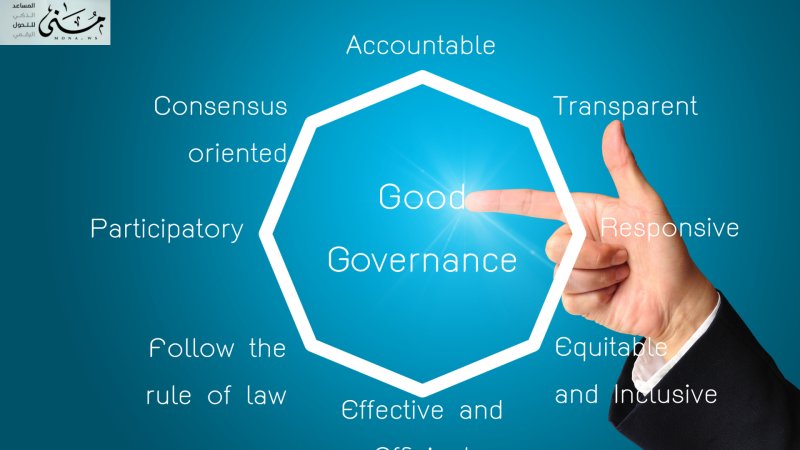Governance in the public sector is one of the foundations that ensures the efficient and transparent management of state institutions, as it achieves a balance between achieving government goals, protecting citizens’ rights, and enhancing confidence in government agencies.
Continue reading the article to learn more about governance in the public sector.
The concept of governance in the public sector
Public sector governance is defined as the framework that defines how government institutions are managed and decisions are made to achieve the state’s goals effectively and efficiently. Public sector governance is based on key principles such as transparency, accountability, participation, fairness, and responsiveness to citizens’ needs. Without sound governance, levels of trust in government agencies may decline, affecting economic and social development.
Public sector governance plays a fundamental role in enhancing government performance, contributing to improved management of financial and human resources, reducing waste and corruption, and enhancing the efficiency of public service delivery.
It also ensures the achievement of social justice, as it enhances opportunities for effective community participation in the decision-making process, leading to more responsive and effective policies.
Principles of Effective Governance
There are many principles of governance in the public sector, including:
Transparency: Ensures clarity in government decision-making and enhances access to public information.
Accountability: Responsibilities are clearly defined, allowing individuals and organizations to be held accountable for their performance.
Participation: It enhances the role of society in formulating public policies, leading to decisions that are more representative of citizens’ interests.
Rule of law: Ensures that laws are applied fairly and without discrimination, which enhances public confidence in government institutions.
Efficiency and effectiveness: Focuses on achieving government goals by using available resources in the best possible way.
Tools and systems to support governance in the public sector
To ensure the effective implementation of governance principles, modern technical systems can be used, such as:
Doc Suite System: An advanced smart platform for managing government documents and communications, ensuring transparency of administrative processes, and improving ease of access to information, which supports accountability and enhances the efficiency of government work.
systemGovernment ERP: It contributes to improving government resource planning and efficient budget management, thus reducing corruption and mismanagement.
Risk Management and Compliance Systems (GRC Systems): Enables monitoring of compliance with laws and policies, and helps improve decision-making.
How do governments enhance governance practices?
Governments enhance governance practices in the public sector by:
- Adopting digital technology in government operations to ensure transparency and speed.
- Establish clear accountability policies that include periodic evaluation of government performance.
- Enhancing citizen participation through electronic platforms that allow for expressing opinions and contributing to decision-making.
Public sector governance is a fundamental pillar for ensuring transparency, accountability and efficiency, and can only be achieved through policy development, the use of modern digital systems, and adherence to the principles of good governance.
The importance of governance for the public sector
Governance in the public sector is not just a regulatory framework, but rather the cornerstone for ensuring that state institutions perform efficiently and fairly, in a way that meets citizens’ aspirations and achieves sustainable development. The importance of governance can be summarized in the following points:
Promoting transparency and public trust
Public sector governance forces government institutions to operate clearly and disclose their policies and decisions, making citizens aware of how public money is managed and decisions are made. This transparency builds trust between citizens and the state, which improves the relationship between the two parties and enhances societal stability.
Fighting corruption and reducing financial waste
Administrative and financial corruption is one of the most prominent obstacles to development. When governance in the public sector is strictly applied, there is effective control over resources, which reduces the opportunities for financial manipulation and bribery, and limits waste resulting from mismanagement.
Improving government performance efficiency
The public sector in many countries may suffer from slowness and complexity of procedures. Governance requires that administrative processes be clear and simplified, which speeds up work and contributes to providing government services with higher quality and at lower costs.
Achieving justice and equality
Governance ensures that all citizens receive their rights to services and opportunities fairly, without mediation or favoritism. For example, the distribution of government support is based on clear criteria, not according to personal relationships.
Promoting accountability
Accountability is one of the most important foundations of governance in the public sector. Government agencies are obligated to submit periodic reports on their performance, and any official who neglects his work will be held accountable. This creates a sense of responsibility among government employees and motivates them to perform their duties in the best possible way.
Support data-driven decision making
Modern governance relies on data in decision-making, which reduces random decisions and contributes to developing policies based on a realistic analysis of society’s needs.
Sustainability of economic development
When the public sector is well managed, the economic environment becomes more stable. Investors prefer countries that apply governance because they provide a clear business environment, which contributes to attracting investments and enhancing economic growth.
Challenges Facing Governance in the Public Sector
Despite the importance of governance, its application in the public sector faces many obstacles, most notably:
Bureaucracy and complexity of procedures
Many government agencies rely on old administrative methods, which depend on paper and long routine procedures. This bureaucracy hinders the speed of decision-making and weakens the ability of institutions to achieve transparency.
Lack of awareness of the importance of governance
In some institutions, the concept of governance is still viewed as a formality, or merely a legal obligation. This limited understanding makes the application of governance in the public sector merely formal, without achieving its real objectives.
Weak control and accounting systems
The lack of effective controls allows some employees to exploit loopholes for personal gain, and weak accounting systems lead to financial errors being discovered at a late stage, making them difficult to address.
The spread of corruption and favoritism
Corruption is one of the biggest enemies of governance in the public sector. When corruption is pervasive, it undermines all reform efforts. Favoritism also undermines confidence in the administrative system, and leads to the preference of the incompetent over the competent.
Weakness of electronic and digital systems
In the face of digital transformation, technology is an essential tool to support governance, but some government sectors still rely on paper, which makes it difficult to implement transparency principles and delays performance development.
Lack of coordination between government agencies
Lack of coordination between ministries and agencies leads to conflicting decisions and hinders the implementation of joint projects. For example, one ministry may rely on a digital system, while another agency still uses paper, which causes a gap in policy implementation.
internal resistance to change
Changing traditional systems may be met with resistance from some employees, especially if they feel that public sector governance will impose strict control over them. This resistance may slow down the implementation of reforms, and may lead to their disruption.
Organizations can overcome these challenges by:
Implementation of modern digital systems: Such as the DocSuite system, which allows for easy organization of administrative documents and communications, which reduces bureaucracy and provides transparency in transactions.
Promoting a culture of accountabilityBy holding training courses for employees, and introducing them to the fact that governance achieves justice and protects their rights as well.
Activate electronic monitoring: Use of advanced control systems, such as risk management and compliance systems (GRC Systems), which monitors organizations’ compliance with laws and detects gaps before they become worse.
Citizen engagementEstablishing electronic platforms that enable citizens to follow up on the performance of government agencies and submit complaints or suggestions, as the Kingdom of Saudi Arabia did through the “Tawasul” platform.
Governance in the public sector is the cornerstone for ensuring efficient performance, achieving justice, and combating corruption. However, its implementation faces real challenges that require the use of modern technology and the dissemination of a culture of transparency and accountability to ensure the building of a strong public sector that responds to citizens’ aspirations.
Ultimately, governance in the public sector proves that it is not just regulatory procedures, but rather the basis for the success of government institutions in providing their services with the highest levels of quality, while preserving public money and enhancing community confidence. With the development of digital systems, it has become necessary to adopt modern solutions such as the Doc Suite system, to ensure the efficient implementation of governance and keep pace with future administrative transformations.
 الحوكمة في القطاع العام تعزز الأداء الحكومي وكفاءة تقديم الخدمات العامة
الحوكمة في القطاع العام تعزز الأداء الحكومي وكفاءة تقديم الخدمات العامة











Comments
Add New Comment